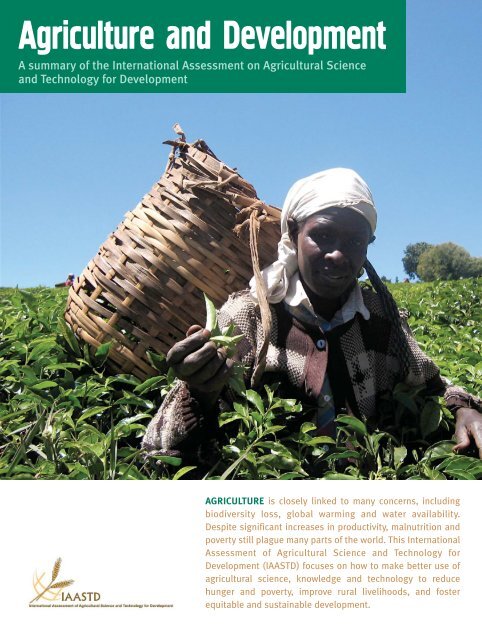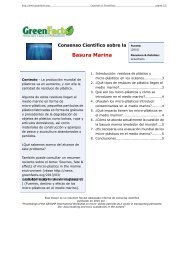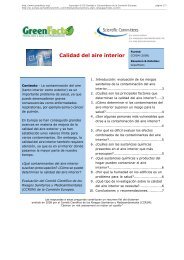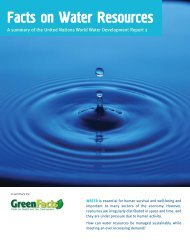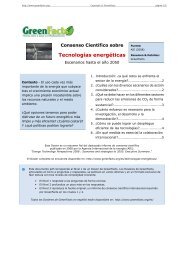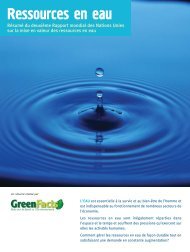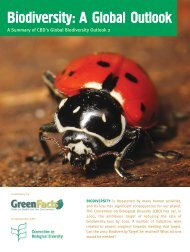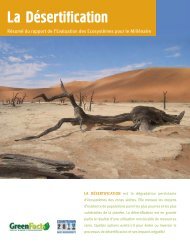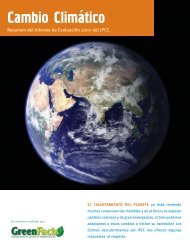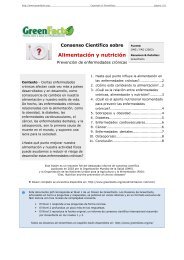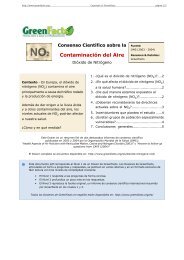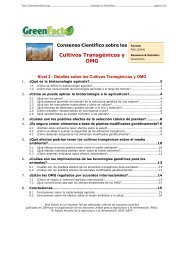Agriculture and Development - GreenFacts
Agriculture and Development - GreenFacts
Agriculture and Development - GreenFacts
Create successful ePaper yourself
Turn your PDF publications into a flip-book with our unique Google optimized e-Paper software.
<strong>Agriculture</strong> <strong>and</strong> <strong>Development</strong><br />
A summary of the International Assessment on Agricultural Science<br />
<strong>and</strong> Technology for <strong>Development</strong><br />
AGRICULTURE is closely linked to many concerns, including<br />
biodiversity loss, global warming <strong>and</strong> water availability.<br />
Despite significant increases in productivity, malnutrition <strong>and</strong><br />
poverty still plague many parts of the world. This International<br />
Assessment of Agricultural Science <strong>and</strong> Technology for<br />
<strong>Development</strong> (IAASTD) focuses on how to make better use of<br />
agricultural science, knowledge <strong>and</strong> technology to reduce<br />
hunger <strong>and</strong> poverty, improve rural livelihoods, <strong>and</strong> foster<br />
equitable <strong>and</strong> sustainable development.
For decades,<br />
agricultural science<br />
has focused on<br />
boosting production<br />
through the<br />
development of<br />
new technologies.<br />
It has achieved enormous yield gains as well as lower costs for largescale<br />
farming. But this success has come at a high environmental cost.<br />
Furthermore, it has not solved the social <strong>and</strong> economic problems of the<br />
poor in developing countries, which have generally benefited the least<br />
from this boost in production.<br />
Today’s world is a place of uneven development, unsustainable use of<br />
natural resources, worsening impact of climate change, <strong>and</strong> continued<br />
poverty <strong>and</strong> malnutrition. Poor food quality <strong>and</strong> diets are partly<br />
responsible for the increase of chronic diseases like obesity <strong>and</strong> heart<br />
Biotechnologies are techniques that use living<br />
organisms to make or modify a product. Some<br />
conventional biotechnologies are well-accepted,<br />
such as fermentation for bread or alcohol<br />
production. Another example is plant <strong>and</strong> animal<br />
breeding to create varieties with better<br />
characteristics or increased yields.<br />
Modern biotechnologies change the genetic code<br />
of living organisms using a technique called genetic<br />
modification. These technologies have been widely<br />
adopted in industrial applications such as enzyme<br />
production.<br />
Other applications remain contentious, such as the<br />
use of genetically modified (GM) crops created by<br />
inserting genes from other organisms. Some GM<br />
crops can bring yield gains in some places <strong>and</strong><br />
declines in others. Because new techniques are<br />
rapidly being developed, longer-term assessments<br />
© Lars Sundström<br />
What are the pros <strong>and</strong> cons of bioenergy?<br />
Bioenergy is heat, electricity, or transport fuel produced from plant or<br />
animal materials. Millions of people still depend on traditional bioenergy<br />
like wood or charcoal for cooking <strong>and</strong> heating, which can be<br />
unsustainable <strong>and</strong> pose health risks.<br />
In many developed countries, the rising costs of fossil fuels, as well as<br />
concerns about energy security <strong>and</strong> climate change, are generating new<br />
interest in other forms of bioenergy. For example, new liquid biofuels are<br />
made from crops or from agricultural <strong>and</strong> forestry residues. However,<br />
energy is needed to grow, transport <strong>and</strong> process bioenergy crops,<br />
causing considerable debate about their net benefit in terms of<br />
greenhouse gas reduction. Another major concern is that using crop l<strong>and</strong><br />
What challenges does agriculture face today?<br />
disease. <strong>Agriculture</strong> is closely linked to these concerns, including the<br />
loss of biodiversity, global warming <strong>and</strong> water availability.<br />
The International Assessment of Agricultural Science <strong>and</strong> Technology for<br />
<strong>Development</strong> (IAASTD) focuses on agriculture as the provider of food,<br />
nutrition, health, environmental services, <strong>and</strong> economic growth that is<br />
both sustainable <strong>and</strong> socially equitable. This assessment recognizes the<br />
diversity of agricultural ecosystems <strong>and</strong> of local social <strong>and</strong> cultural<br />
conditions.<br />
It is time to fundamentally rethink the role of agricultural knowledge,<br />
science <strong>and</strong> technology in achieving equitable development <strong>and</strong><br />
sustainability. The focus must turn to the needs of small farms in diverse<br />
ecosystems <strong>and</strong> to areas with the greatest needs. This means improving<br />
rural livelihoods, empowering marginalized stakeholders, sustaining<br />
natural resources, enhancing multiple benefits provided by ecosystems,<br />
considering diverse forms of knowledge, <strong>and</strong> providing fair market<br />
access for farm products.<br />
to produce fuel could raise food prices, drive small-scale farmers off their<br />
l<strong>and</strong> <strong>and</strong> prolong hunger in the world.<br />
Electricity <strong>and</strong> heat can also be obtained from plant residues <strong>and</strong> animal<br />
wastes, either by burning them directly or by first producing biogas then<br />
burning it. These renewable energy sources usually produce less<br />
greenhouse gas emissions than other fuels. They can be effective, for<br />
instance in places not connected to the electric grid.<br />
Decision-makers should compare all forms of bioenergy to other<br />
sustainable energy options <strong>and</strong> carefully weigh full social, environmental<br />
<strong>and</strong> economic costs against realistically achievable benefits. Decisions in<br />
this context are heavily influenced by local conditions.<br />
Can biotechnology help meet the growing dem<strong>and</strong> for food?<br />
of environmental <strong>and</strong> health risks <strong>and</strong> benefits tend<br />
to lag behind discoveries. This increases<br />
speculation <strong>and</strong> uncertainty.<br />
The possibility of patenting genetic modifications<br />
can attract investment in agricultural research. But<br />
it also tends to concentrate ownership of resources,<br />
drive up costs, inhibit independent research, <strong>and</strong><br />
undermine local farming practices such as seedsaving<br />
that are especially important in developing<br />
countries. It could also mean new liabilities, for<br />
example if a genetically modified plant spreads to<br />
nearby farms.<br />
Many problems could be solved if biotechnologies<br />
would focus on local priorities identified through<br />
transparent processes involving the full spectrum of<br />
stakeholders.<br />
Biotechnologies are already<br />
widely used in agriculture.<br />
© Part of the image collection of the International Rice Research Institute (www.irri.org)
How is climate change threatening agriculture?<br />
<strong>Agriculture</strong> has contributed to climate change in<br />
many ways, for instance through the conversion<br />
of forests to farml<strong>and</strong> <strong>and</strong> the release of<br />
greenhouse gases. Conversely, climate change<br />
now threatens to irreversibly damage natural<br />
resources on which agriculture depends.<br />
The effects of global warming are already visible<br />
in much of the world. In some areas, moderate<br />
warming can slightly increase crop yields. But<br />
overall, negative impacts will increasingly<br />
dominate. Floods <strong>and</strong> droughts become more<br />
frequent <strong>and</strong> severe, which is likely to seriously<br />
affect farm productivity <strong>and</strong> the livelihoods of<br />
rural communities, <strong>and</strong> increase the risk of<br />
conflicts over l<strong>and</strong> <strong>and</strong> water. Also, climate<br />
change encourages the spread of pests <strong>and</strong><br />
invasive species <strong>and</strong> may increase the<br />
geographical range of some diseases.<br />
Some l<strong>and</strong> use management approaches can<br />
help mitigate global warming. These include<br />
planting trees, restoring degraded l<strong>and</strong>,<br />
conserving natural habitats, <strong>and</strong> improving soil<br />
<strong>and</strong> fertility management. Policy options<br />
include financial incentives to grow trees,<br />
reduce deforestation <strong>and</strong> develop renewable<br />
Although food production has increased in recent decades, many people<br />
remain undernourished, a problem accounting for 15% of global disease.<br />
Many population groups still face protein, micronutrient <strong>and</strong> vitamin<br />
deficiency. Meanwhile, obesity <strong>and</strong> chronic diseases are increasing<br />
across the world because of people eating too much of the wrong foods.<br />
Agricultural research <strong>and</strong> policies should be devised to increase dietary<br />
diversity, improve food quality, <strong>and</strong> promote better food processing,<br />
preservation <strong>and</strong> distribution.<br />
Global trade <strong>and</strong> growing consumer awareness have increased the need<br />
for proactive food safety systems. Health concerns include the presence<br />
of pesticide residues, heavy metals, hormones, antibiotics, <strong>and</strong><br />
Can traditional knowledge contribute to agriculture?<br />
Many effective innovations are generated locally, based on the<br />
knowledge <strong>and</strong> expertise of indigenous <strong>and</strong> local communities rather<br />
than on formal scientific research. Traditional farmers embody ways of<br />
life beneficial to the conservation of biodiversity <strong>and</strong> to sustainable rural<br />
development.<br />
energy sources. <strong>Agriculture</strong> <strong>and</strong> other rural<br />
activities must be integrated in future<br />
international policy agreements on climate<br />
change. However, since some changes in the<br />
climate are now inevitable, adaptation<br />
measures are also imperative.<br />
How is food production affecting health?<br />
additives in the food system, as well as risks related to large-scale<br />
livestock farming.<br />
Worldwide, agriculture accounts for at least 170 000 work-related deaths<br />
each year. Accidents with equipment like tractors <strong>and</strong> harvesters cause<br />
many of these deaths. Other important health hazards for agriculture<br />
workers include noise, transmissible animal diseases, <strong>and</strong> exposure to<br />
toxic substances such as pesticides.<br />
<strong>Agriculture</strong> can contribute to the emergence <strong>and</strong> spread of infectious<br />
diseases. Therefore, robust surveillance, detection <strong>and</strong> response<br />
programs are critical across the food chain.<br />
Local <strong>and</strong> traditional knowledge has been successfully built into several<br />
areas of agriculture, for example in the domestication of wild trees, in<br />
plant breeding, <strong>and</strong> in soil <strong>and</strong> water management. Scientists should<br />
work more closely with local communities <strong>and</strong> traditional practices<br />
should have a higher profile in science education. Efforts should be<br />
made to archive <strong>and</strong> evaluate the knowledge of local people <strong>and</strong> to<br />
protect it under fairer international intellectual property legislation.<br />
This text is a faithful summary, by <strong>GreenFacts</strong>, of the Synthesis Report of the International Assessment on Agricultural Science<br />
<strong>and</strong> Technology for development. A web version of this summary, along with the full IAASTD Synthesis Report,<br />
can be found on www.greenfacts.org/en/agriculture-iaastd/.
How can agriculture make better use of natural resources?<br />
Historically, agricultural development was geared towards increasing<br />
productivity <strong>and</strong> exploiting natural resources, but ignored complex<br />
interactions between agricultural activities, local ecosystems, <strong>and</strong> society.<br />
These interactions must be considered to enable sustainable use of<br />
resources like water, soil, biodiversity <strong>and</strong> fossil fuels. Much of the<br />
agricultural knowledge, science <strong>and</strong> technology needed to resolve today’s<br />
challenges are available <strong>and</strong> well understood, but putting them into<br />
practice requires creative efforts from all stakeholders.<br />
Existing agricultural science <strong>and</strong> technology can tackle some of the<br />
underlying causes of declining productivity. But further developments<br />
based on a multidisciplinary approach are needed, starting with more<br />
monitoring of how natural resources are used. Other options for action<br />
include more research into how to use natural resources responsibly <strong>and</strong><br />
efforts to foster public awareness of their importance.<br />
Small farmers <strong>and</strong> rural communities in developing countries have often<br />
not benefited from opportunities that agricultural trade can offer.<br />
Opening farm markets prematurely to international competition can<br />
further weaken the agricultural sector of a developing country, causing<br />
more poverty, hunger <strong>and</strong> harm to the environment in the long-term.<br />
Trade reforms could make relations more equitable. Developing<br />
countries would benefit from key changes such as removing trade<br />
barriers on products for which they have a competitive advantage;<br />
Local market in Pisac, Peru.<br />
Why haven’t small farmers benefited more from global trade?<br />
lowering tariffs on imports of processed commodities; <strong>and</strong> improving<br />
their access to export markets.<br />
The capacity of developing countries to analyze <strong>and</strong> negotiate trade<br />
agreements needs to be strengthened to allow better <strong>and</strong> more<br />
transparent decisions concerning the agricultural sector.<br />
The environmental footprint of agriculture could be reduced by adapting<br />
market <strong>and</strong> trade policies, for instance by removing detrimental<br />
subsidies, changing taxation policies, <strong>and</strong> improving property laws.<br />
What is the role of women in agriculture <strong>and</strong> development?<br />
Current trends in globalization <strong>and</strong> rising<br />
environmental <strong>and</strong> sustainability concerns are<br />
redefining the relationship of women to<br />
agriculture <strong>and</strong> development.<br />
The proportion of women involved in<br />
agricultural activities ranges from 20% to 70%,<br />
a number that is climbing in many developing<br />
countries, especially where agriculture is geared<br />
towards export.<br />
Although some progress has been made,<br />
women continue to struggle with low income,<br />
limited access to education, credit <strong>and</strong> l<strong>and</strong>, job<br />
insecurity, <strong>and</strong> deteriorating work conditions.<br />
Growing competition has fueled dem<strong>and</strong> for<br />
cheap, flexible labor, <strong>and</strong> conflicts over access<br />
to natural resources have added to the<br />
pressure. Poor rural households are increasingly<br />
threatened by natural disaster, environmental<br />
change <strong>and</strong> health <strong>and</strong> safety risks – this at a<br />
time of diminishing government support.<br />
© Eva Schuster
Conclusion: What are the options for action?<br />
Fighting poverty <strong>and</strong> improving rural livelihoods<br />
Small-scale farmers would benefit from greater access to knowledge, technology, <strong>and</strong> credit, <strong>and</strong>, critically, from more political<br />
power <strong>and</strong> better infrastructure. They need laws that secure access to l<strong>and</strong> <strong>and</strong> natural resources as well as fair intellectual<br />
property rights.<br />
Enhancing food security<br />
Ensuring food security is not merely a matter of producing enough to eat: food must also be available to those who need it.<br />
Possible policy actions that can enhance access to food include reducing transaction costs for small-scale producers,<br />
strengthening local markets <strong>and</strong> improving food safety <strong>and</strong> quality. Global systems are needed to watch out for sudden price<br />
changes <strong>and</strong> extreme weather events that could lead to food shortages <strong>and</strong> price-induced hunger.<br />
Using natural resources in a sustainable way<br />
Agricultural sustainability means maintaining productivity while protecting the natural resource base.<br />
Possible actions include: improving low impact practices such as organic agriculture <strong>and</strong> providing incentives for the sustainable<br />
management of water, livestock, forests, <strong>and</strong> fisheries. Science <strong>and</strong> technology should focus on ensuring that agriculture not only<br />
provides food but also fulfills environmental, social <strong>and</strong> economic functions such as mitigating climate change <strong>and</strong> preserving<br />
biodiversity. Policy-makers could end subsidies encouraging unsustainable practices <strong>and</strong> provide incentives for sustainable<br />
natural resource management.<br />
Improving human health<br />
Human health can be improved through efforts to diversify diets <strong>and</strong> enhance their nutritional value, through advances in<br />
technologies for processing, preserving <strong>and</strong> distributing food, <strong>and</strong> through better health policies <strong>and</strong> systems.<br />
Food safety can be increased by investing in infrastructure, public health <strong>and</strong> veterinary capacity, <strong>and</strong> by developing legal<br />
frameworks for controlling biological <strong>and</strong> chemical hazards. Work-related health risks can be reduced by enforcing health <strong>and</strong><br />
safety regulations. The spread of infectious diseases like bird flu can be limited through better coordination across the food chain.<br />
Helping achieve equity in agriculture<br />
Achieving greater equity in agriculture requires investment to bring technology <strong>and</strong> education to rural areas. Fair access to l<strong>and</strong><br />
<strong>and</strong> water is crucial. Stakeholders should be allowed to influence decisions about use <strong>and</strong> management of natural resources,<br />
access to l<strong>and</strong>, credit <strong>and</strong> markets, intellectual property rights, trade priorities, <strong>and</strong> protection of the rural environment. Above all,<br />
farmers need to be rewarded for their labor with just <strong>and</strong> fair prices for their products.<br />
GLOSSARY GLOSSARY GLOSSARY GLOSSARY GLOSSARY GLOSSARY GLOSSARY GLOSSARY<br />
Bioenergy – Renewable energy made from<br />
materials from biological sources. Wood,<br />
charcoal, manure <strong>and</strong> crop residues are all<br />
traditional forms of bioenergy. Bioenergy<br />
produced from crops like maize or<br />
sugarcane is known as biofuel, while<br />
biogas refers to the mixture of methane<br />
<strong>and</strong> carbon dioxide produced by the<br />
bacterial decomposition of organic wastes.<br />
Biotechnology – Any technological<br />
application that uses biological systems,<br />
living organisms, or their derivatives to<br />
make or modify products or processes for<br />
specific use. Examples of biotechnology<br />
include traditional applications such as<br />
the making of bread, cheese, wine, <strong>and</strong><br />
beer, <strong>and</strong> more modern ones such as cell<br />
culture, genetically modified foods or<br />
cloning plants <strong>and</strong> animals.<br />
Genetically modified crops – Crops produced<br />
from organisms that have had their genome<br />
altered through genetic engineering.<br />
Microcredit – The lending of very small<br />
amounts of money at low interest.<br />
Micronutrient – Any essential nutrient, as a<br />
trace mineral or vitamin, that is required<br />
by an organism in minute amounts.<br />
Renewable energy – Any naturally occurring,<br />
theoretically inexhaustible source of<br />
energy not derived from fossil or nuclear<br />
fuel. Examples include solar, wind <strong>and</strong><br />
water power.<br />
Sustainability – Characteristic or state<br />
whereby the needs of the present <strong>and</strong><br />
local population can be met without<br />
compromising the ability of future<br />
generations or populations in other<br />
locations to meet their needs.<br />
Transgene – A gene from one organism that<br />
has been incorporated into the genome of<br />
another organism. Often refers to a gene<br />
that has been introduced into a<br />
multicellular organism.<br />
© Denis Tarantola
The International Assessment of Agricultural Science<br />
<strong>and</strong> Technology for <strong>Development</strong> (IAASTD)<br />
Facts on this leaflet<br />
This leaflet is a faithful summary of the IAASTD Synthesis Report. It was produced by <strong>GreenFacts</strong> under contract with COM+ alliance <strong>and</strong><br />
carefully reviewed by scientists who took part in the IAASTD process.<br />
This publication was produced by:<br />
The IAASTD addresses how to make better<br />
use of agricultural science, knowledge <strong>and</strong><br />
technology to reduce hunger <strong>and</strong> poverty,<br />
improve rural livelihoods, <strong>and</strong> foster<br />
equitable <strong>and</strong> sustainable development.<br />
Released on 15 April 2008, it represents a three-year effort by about<br />
400 experts around the world working under the auspices of 30<br />
governments <strong>and</strong> 30 representatives of civil society. The latter include<br />
nongovernmental organizations, producer <strong>and</strong> consumer groups <strong>and</strong><br />
international organizations.<br />
The assessment was sponsored by the United Nations, the World Bank<br />
<strong>and</strong> the Global Environment Facility (GEF), an independent financial<br />
organization that provides grants to developing countries. Five U.N.<br />
agencies were involved: the Food <strong>and</strong> Agricultural Organization (FAO),<br />
the U.N. <strong>Development</strong> Program (UNDP), the U.N. Environment<br />
Programme (UNEP), the U.N. Education, Science <strong>and</strong> Cultural<br />
Organization (UNESCO) <strong>and</strong> the World Health Organization (WHO).<br />
Additional individuals, organizations <strong>and</strong> governments participated in<br />
a peer review process.<br />
IAASTD publications can be found at www.agassessment.org.<br />
“If we do persist with business as usual, the world’s people<br />
cannot be fed over the next half-century. It will mean<br />
more environmental degradation, <strong>and</strong> the gap between<br />
the haves <strong>and</strong> have-nots will further widen.<br />
We have an opportunity now to marshal our intellectual<br />
resources to avoid that sort of future.<br />
Otherwise we face a world no one would want to inhabit.”<br />
This summary can be found at www.greenfacts.org/en/agriculture-iaastd/<br />
<strong>GreenFacts</strong> is an independent non-profit organization that publishes faithful online summaries of leading scientific<br />
documents produced by international bodies such as the Intergovernmental Panel on Climate Change, the<br />
Millennium Ecosystem Assessment or the World Health Organization. All <strong>GreenFacts</strong> summaries are peer-reviewed<br />
by independent experts.<br />
www.greenfacts.org | 2008@greenfacts.org | Tel: +32 (0)2 211 34 88<br />
The Com+ alliance is a partnership of international organizations <strong>and</strong> communications professionals from diverse<br />
sectors committed to using communications to advance a vision of sustainable development that integrates its three<br />
pillars: economic, social <strong>and</strong> environmental. By offering a platform to share expertise, develop best practice <strong>and</strong> create<br />
synergies, Com+ hopes to actively support creative <strong>and</strong> inspiring communications across the world.<br />
www.complusalliance.org | info@complusalliance.org | Tel: + 1 506 241 0101<br />
Texts © <strong>GreenFacts</strong> asbl/vzw – reproduction welcome; please contact <strong>GreenFacts</strong> for conditions.<br />
Cover picture: Judy Kuo<br />
Professor Robert Watson,<br />
Director of the IAASTD Secretariat<br />
“On a global scale, we have been producing sufficient food<br />
for an ever growing population. But this has been done<br />
at a cost that has left deep physical, biological<br />
<strong>and</strong> social scars, that now need the full attention<br />
of the scientific, moral <strong>and</strong> political authorities.<br />
This assessment highlights the present reality <strong>and</strong><br />
identifies options for action in a c<strong>and</strong>id <strong>and</strong> sober manner.”<br />
Dr. Hans R Herren,<br />
World Food Prize Laureate, Co-Chair of the IAASTD<br />
“We cannot continue to work independently in our silos.<br />
We have an array of agricultural knowledge, science<br />
<strong>and</strong> technology tools that can solve the pressing food<br />
security challenges that we face.”<br />
Professor Judi Wakhungu,<br />
Co-Chair of the IAASTD<br />
Editeur responsable: Jacques Wirtgen, <strong>GreenFacts</strong> asbl/vzw, Rue des Palais 44 Paleizenstraat, 1030 Brussels, Belgium – Registered office: 163 Bld Reyerslaan, 1030 Brussels ■ Concept & layout: beëlzePub ■ Printed on 100% recycled paper


